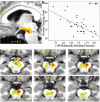Midbrain dopamine receptor availability is inversely associated with novelty-seeking traits in humans
- PMID: 19118170
- PMCID: PMC2748420
- DOI: 10.1523/JNEUROSCI.2423-08.2008
Midbrain dopamine receptor availability is inversely associated with novelty-seeking traits in humans
Abstract
Novelty-seeking personality traits are a major risk factor for the development of drug abuse and other unsafe behaviors. Rodent models of temperament indicate that high novelty responding is associated with decreased inhibitory autoreceptor control of midbrain dopamine neurons. It has been speculated that individual differences in dopamine functioning also underlie the personality trait of novelty seeking in humans. However, differences in the dopamine system of rodents and humans, as well as the methods for assessing novelty responding/seeking across species leave unclear to what extent the animal models inform our understanding of human personality. In the present study we examined the correlation between novelty-seeking traits in humans and D(2)-like (D(2)/D(3)) receptor availability in the substantia nigra/ventral tegmental area. Based on the rodent literature we predicted that novelty seeking would be characterized by lowered levels of D(2)-like (auto)receptor availability in the midbrain. Thirty-four healthy adults (18 men, 16 women) completed the Tridimensional Personality Questionnaire-Novelty-Seeking Scale and PET scanning with the D(2)/D(3) ligand [(18)F]fallypride. Novelty-Seeking personality traits were inversely associated with D(2)-like receptor availability in the ventral midbrain, an effect that remained significant after controlling for age. We speculate that the lower midbrain (auto)receptor availability seen in high novelty seekers leads to accentuated dopaminergic responses to novelty and other conditions that induce dopamine release.
Figures



References
-
- AblerB, Walter H, Erk S, Kammerer H, Spitzer M (2006) Prediction error as a linear function of reward probability is coded in human nucleus accumbens. Neuroimage 31:790–795. - PubMed
-
- AdellA, Artigas F (2004) The somatodendritic release of dopamine in the ventral tegmental area and its regulation by afferent transmitter systems. Neurosci Biobehav Rev 28:415–431. - PubMed
-
- AghajanianGK, Bunney BS (1977) Dopamine “autoreceptors”: pharmacological characterization by microiontophoretic single cell recording studies. Naunyn Schmiedebergs Arch Pharmacol 297:1–7. - PubMed
-
- BergerB, Gaspar P, Verney C (1991) Dopaminergic innervation of the cerebral cortex: unexpected differences between rodents and primates. Trends Neurosci 14:21–27. - PubMed
Publication types
MeSH terms
Substances
Grants and funding
LinkOut - more resources
Full Text Sources
Medical
